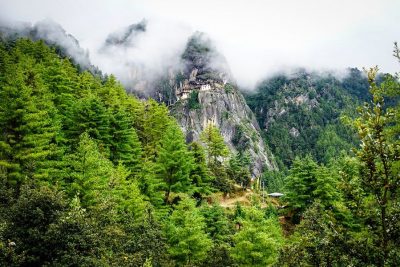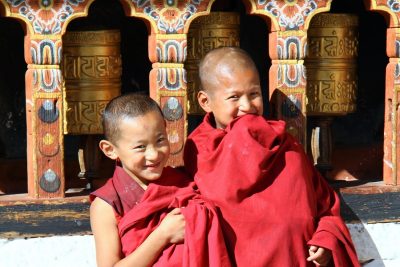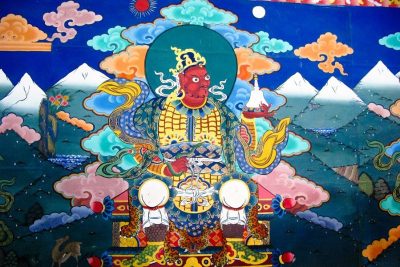The essence of Bhutan
9 Days
ABOUT THE ITINERARY
This itinerary is thought in order to experience the most important sites of Bhutan in a compact tour of only 8 days. Bhutan, unlike its other Himalayan neighbours, considers all creation sacred, including trees, mountains, rivers, lakes and animals. Consequently, some Himalayan species near extinction in the bordering countries of Nepal, India, and Tibet are doing well in Bhutan. Bhutan is also the last bastion of Vajrayana Buddhism, a spiritual practice that is known to be one of the most profound schools of teaching in the Buddhist world. The sacred monasteries, the fluttering prayer flags that line the high ridges, the red robed monks chanting their prayers — all give this kingdom an aura of another time. Even if in a short period of time you will have the chance to discover the best that Bhutan has to offer. The sacred Paro Taktshang, so called Tiger Nest was blessed during 7th century, by the great tantric master, Guru Rinpoche, who came here by his miraculous flying on the back of flaming tigress in form of Guru Dorje Drolo from Khenpajong (eastern Bhutan) on his way from Tibet, to advocate the Buddhism teaching in Mon-Yul (place of darkness). During this itinerary at the discovery of the essence of Bhutan you will have the rare chance of experiencing a full day meditation program with monks in Dodeydra Monastry, where for a full day you will live in a monastery together with monks. Moreover, in Thimpu you will discover two of the major organisations involved in education of youth through the teaching of traditional arts.
JOURNEY OVERVIEW AND PROGRAM DETAILS
DAY 1: Arrival in Kolkata
Kolkata
Arrival at Calcutta international airport. Transfer to hotel for refreshing and rest. Kolkata, formerly Calcutta, is the capital of the Indian state of West Bengal. Located on the east bank of the Hooghly river, it is the principal commercial, cultural, and educational centre of East India, while the Port of Kolkata is India’s oldest operating port as well as its sole major riverine port. As the former capital of British India, Kolkata retains a feast of colonial-era architecture contrasting starkly with urban slums and dynamic new-town suburbs with their air-conditioned shopping malls. Afternoon short city tour which also includes a country boat ride on the Ganges to experience the glorious sun set.
Overnight in Kolkata (B)
DAY 2: fly to paro
Kolkata – Paro – Thimpu
Transfer to airport for flight to Paro, your introduction to our enchanting kingdom begins on a flight over the Himalayas into the lush green valley of Paro; truly one of The world’s most spectacular sights. During your flight, You will view the world’s highest, most majestic peaks and enjoy the view of the approaching valley with its primeval alpine forest, monasteries, temples and farmhouse nestled in splendid mountain isolation. On arrival to Paro you will be received by our representative, the tour guide, and driven to Thimphu, the capital city. The beautiful drive From Paro to Thimphu takes about an hour, following the Paro River till its confluence. After the confluence, you will take the road along the Thimphu river valley till the capital city of Thimphu.check in the hotel. Later part of the day visit the tallest ‘sitting Buddha’ statue, Memorial Chorten, National Animal Takin. Later a visit to CTAS (Choki Traditional Art School) located just north of the capital of Bhutan, in the beautiful mountain valley of Kabesa. Established in 1999, the school trains disadvantaged youth in the traditional skills of drawing, ‘thangka’ painting, weaving, embroidery, sculpture and wood carving. Students live, study, learn skills for their livelihood and work in the school, which is a collection of traditional Bhutanese buildings, white painted, on the side of a sunny hill amid farms and villages. Currently 136 girls and boys attend and they range in ages from 15 to 25. Students typically study for six years at the school. Here you will have the chance to interact with students and learn one of the arts. In the evening. In the late afternoon you will have a chance to discuss about GNH (gross National Happiness) with local experts. Evening free to stroll around Thimphu.
Overnight in Thimpu (B/L/D)
DAY 3: HIKE TO CHERI MONASTRY
Thimphu
After breakfast you will hike to Cheri Goemba monastery Drive 30 minutes to Dodena and hike about 45 minute through beautiful forest trails to Cheri Monastery built in 1620. Cheri Monastery Hike gives you an insight into the natural discovery of Himalayan vegetation. The hiking trail passes through the off-beaten forest where one often gets to spot a variety of birdlife. The hike to this very scenic monastery is steep but relatively short, with several sacred sites scattered throughout the lush forest. Along the way there is a good chance of encountering wild animals (monkeys, deer…). Cheri monastery is one of the main retreat centres and a popular pilgrimage site in the country. Cheri Gompa was founded by Ngawang Namgyal, the Rinpoche who unified Bhutan as one political and spiritual entity. Its main function is as a retreat centre for the Drukpa Kagyu school of Vajrayana Buddhism. You can see a beautiful painting of Guru on the solid rock. Picnic lunch will be served near the river bank near wooden bridge. After lunch visit Pangri Zampa Astrological collage where if you are interested, you can meet with an astrologer for a consultation.
Overnight in Thimpu (B/L/D)
DAY 4: TRANSFER TO PUNAKHA
Thimphu – Punakha
After breakfast drive to Punakha (around 2 hrs) on a black topped smooth Road. Enjoy a breath-taking mountain view along the way. Arriving at Dochu-la, a pass at 3140 metres, have a short break to drink a hot tea or coffee while breathing in the fresh air of the high mountains and, if the skies are clear, admire the immense snow-capped peaks of the High Himalayas as we walk among the 108 chorten that decorate it. After a comfortable and spectacular descent (Bhutan’s roads are paved and well maintained), we will reach a small traditional restaurant for lunch, after we will take a walk-through rice fields until we reach the Chimi Lhakhang. This temple was founded by Drukpa Kunley, the famous and beloved holy-folk of Bhutan, a beautiful man and tantric master extraordinaire who used every means to bring his disciples to very high levels of contemplative realisation. After visit at the majestic Punakha Dzong, built between 1637 and 1638 at the confluence of Pho Chhu and Mo Chhu rivers.
Overnight in Punakha (B/L/D).
DAY 5: EXPERIENCE A LOCAL FARM HOUSE IN PUNAKHA
Punakha
After breakfast you will start exploring Punakha valley culture and traditions. We will we drive to Nubgange village. Here you can engage in the farm house activities, such as, darts, archery and field work. Here you will have to have a cooking demonstration while preparing your lunch. Later hike down through villages with its quaint farming activities and the rural life in general. You can view the magnificent Punakha Dzong from this hike. Later you can enjoy a hot stone bath (optional).
Overnight in Punakha (B/L/D).
DAY 6: LIVING A DAY IN A MONASTRY
Punakha – Dodeydra Monastry
After breakfast Transfer towards hike to Dodeydra monastery. If you love nature, tranquillity, butterflies and the off beaten track then Dodeydra hike has a lot to offer. This beautiful and easy hike takes you to a hidden land, providing a hiker a sense of awe and wonder and a point of self-reflection along the way. The name Dodeydra has been derived from the split rock from where the Ter (Hidden Treasure) in the form of scripture was discovered. The monastery is beautifully built between the split rock and it has two altars and beautiful paintings on the wall. The monastery also houses a small museum with many historic and religious artifacts and stories attributed to one of the Chief Abbot Jamyang Gyeltshen, considered an acclaimed craftsman who made numerous statues and paintings/murals. There are around 175 monks living here so today you will have a chance to learn how Buddhism is practiced in Bhutan. In the afternoon you will attend a meditation session on Samtha or vipassana. At 6,30 pm you can join the monks for the evening prayer.
Overnight in the Monastery guest house or in a camp site (B/L/D).
DAY 7: DEPART PARO
Dodeydra – Paro
Early morning you can participate in morning prayer from 5:30 AM to 6:15Am. After breakfast hike to Jungzhina . Then by car continuing to Paro and check in the hotel. After some rest visit the Kychu Lhakhang (temple). This is one of the oldest and most sacred shrines of Bhutan. The inner temple was built by a Buddhist Tibetan King, Srongtsen Goempo in the 7th century. Visit Paro Dzong, the 17th century fortress. The Dzong is the seat of the district administration as well as the home for the monastic school. The central tower (Utse) of the Dzong, with its superb woodwork, is one of the most beautiful in the country. Evening walk around Paro town
Overnight in Paro (B/L/D)
DAY 8: HIKE TO TIGER NEST MONASTERY
Paro
After breakfast start the day with short drive to Paro’s upper valley. On a clear day you’ll have an unforgettable view of the “Goddess” Mt. Chomolhari at 23,640 feet. Afterward, it’s a short drive to Taksang trail head. Hike to Taksang Monastery, the most famous monastery in Bhutan. Taksang means “Tiger Nest” so named because Guru Rinpoche reportedly flew to the site on the back of a flying tiger late in the 7th century. Between blue pines and a blue sky, the monastery perches miraculously on a cliff nearly 2,700feet above Paro’s valley floor. Offer butter lamp here. Have lunch at Takshang Café. Later visit a farm house where you will be able to see various Bhutanese traditional way of making rice wine, the Zaw, the Suja making (butter tea), learn traditional game of Archery and Degor (play with stone). Evening Enjoy a traditional hot stone bath. Back to hotel for a well earned rest.
Overnight in Paro (B/L/D).
DAY 9: DEPART FROM PARO
Morning after breakfast you will transfer to the airport. Say goodbye to Bhutan and board a flight for onward destinations.
ACTIVITIES
- Discover the city of Kolkata,
- Explore the cultural and ecological richness of Bhutan,
- Take part in art and crafts activities in Choki Traditional Arts School,
- Hike about 45 minute through beautiful forest trails to Cheri Monastery
- witness an archery game going on the way to Paro,
- Enjoy an unforgettable view of the “Goddess” Mt.Chomolhari,
- take a walk through paddy field to Temple of fertility Chimmi Lhakhang temple in Punakha,
- Visit a farm house in Punakha where you will be able to see various Bhutanese traditional way of making rice wine,
- Participate for a full day in the activities of monks in Dodeydra Monastry,
- Visit the Rinpung Dzong (which means fortress on a heap of jewels) in Paro and walk down to the traditional wooden covered bridge,
- Day hike to Taksang, the famous Tiger’s Nest Monastery,
- Visit temples and Monasteries.
SOCIAL AND ENVIRONMENTAL IMPACT
All the itinerary has been designed in order to promote direct or indirect benefits for local communities, environment and cultural heritages. When possible, we have selected traditional accommodations sensible to social and environmental issues, following general principles and practices of responsible tourism. For the benefit of local community, the Bhutan government decide to open few indigenous village for visitor whilst conserving the natural resources and respecting their way of life, which involves communities to be environmentally sustainable, contribute to the community school, library, also conservation of wild life project. Some of these are contribution to the Gross National Happiness (GNH).
In Thimpu, the capital of Bhutan, the tour will support the CTAS “Choki Traditional Art School”, whose main mission is to preserve the traditional arts and crafts of Bhutan from fading away, and to empower youth with livelihood skills. This school is the only private institute providing training on traditional arts and crafts in Bhutan. It provides free tuition, food and lodging facilities to the economically disadvantaged youth of Bhutan. By teaching and promoting traditional skills of Bhutan the institute has high potential to create new jobs. Zorin Chusum (Thirteen Crafts) can provide a real source of income and employment.
In Thimpu you will also visit a Voluntary Artists’ Studio, known as VAST, which was set up in 1998 by a group of professional artists as a non-profitable and non-governmental organization (NGO). This informal organization was set up with the sole aim of providing an opportunity to the Bhutanese youth to participate and develop their potential talents as well as share social responsibilities through artistic explorations and other socially useful and productive work. Its primary objective is to provide potential vocational skills and alternative positive use of free time and facilitate participation in the national and international art realm. You will have an exposure visit to the youth centenary village, part of “Simply Bhutan”, an unique project of the Bhutan Youth Development Fund. This institution runs programs in order to build leadership skills, encourage teamwork and promote the value of service among youth. Through advocacy work and strategic partnerships, the Fund works to encourage youth participation, raise awareness of youth issues and promote youth-oriented policy. We invest in Bhutan’s future, one youth at a time.
TIPS BEFORE DEPARTURE
A conscious approach to travel requires a considerable capacity and willingness to adapt and adjust to the local environment and culture. If you wish to travel with us we request you to be open enough to experience local culture, religious and traditions without bias and pre-conceived ideas you might have before the departure and which belong to our Western cultural way of thinking. Exploring with fresh eyes, with patience and openness, you will be able to access the real essence of the cultural heritages and spirituality through the places and people you are going to meet; if you are ready to do this effort you will really enjoy the beauty of the rich culture and religiousness of Bhutan, the extraordinary of the nature, the solemnity of Buddhist monasteries and the holy sites blessed by Guru Padmasambhava himself.
In Bhutan the weather could get wet with sporadic or long showers. Please pack appropriate clothing. Bhutan’s changeable climate means you have to bring an assortment of clothes, including rain gear. Mornings and evenings could be quite cold. Carry with you appropriate warm clothing especially for the evening. A layered wardrobe probably makes the most sense. However, warm clothing is required throughout but more specifically from October to April. Good walking shoes or hiking boots are essential even if you are not hiking. Because of the altitude, a hat or cap and a good pair of sunglasses are essential. Because of the long distances between towns and villages bring the medicines you’ll need along with some first-aid supplies. A good flashlight (torch), water bottle and polarizing filter for your camera will also come in very handy. A backpack is necessary to carry essentials/cameras while you are on local excursions. Monasteries and temples are places of worship, so you should be dressed accordingly. Admission might be denied to men and women wearing short pants/skirts, sleeveless t-shirts/blouses.
Getting to Bhutan is not quite straightforward. The Bhutanese Government monitors visitors into and out of Bhutan. On entry into Bhutan, you will meet an official recognised guide, who will escort you everywhere. He will be with you until you depart. You are strongly recommended to engage with us at an early stage of you are planning to visit Bhutan during Festival periods.
This itinerary offers good opportunities for cultural exchange, adventure, hiking, wildlife spotting and moderate trekking. However it is not fit for everyone, due to moderate trekking and altitude. Check with your physician to confirm that you are healthy to travel. Inform your doctor where you are going to see if there are any special concerns. Because of the climate and general lack of medical facilities in the villages, you should be reasonably fit before departure.
HOTELS
In Bhutan, we have selected mid category hotels with all the major facilities and comforts but in the true tradition of Bhutanese hospitality.
TRANSPORT
We will be using comfortable and air-conditioned mini-coach/van throughout the entire trip.
WHEN TO GO
It is possible to visit Bhutan all year around but the best weather is generally:
Mar–May (spring)/ MidSep–MidNov (autumn). Spring (March April & May) is the most beautiful time of the year, resplendent and ablaze with a spectacular array of bright colours. Also, it is the time to witness the famous Paro tsechu festival. The Paro Tshechu is held every spring and is one of the most colourful and significant events in Paro Dzongkhag (district). Autumn (September, October & November) is lovely with clear and crisp blue skies, providing a grand view of some of the tallest unclimbed mountains in the world. It is the best time for trekking and for travelling. This is instead the right time to assist to the Thimphu tsechu festival!




